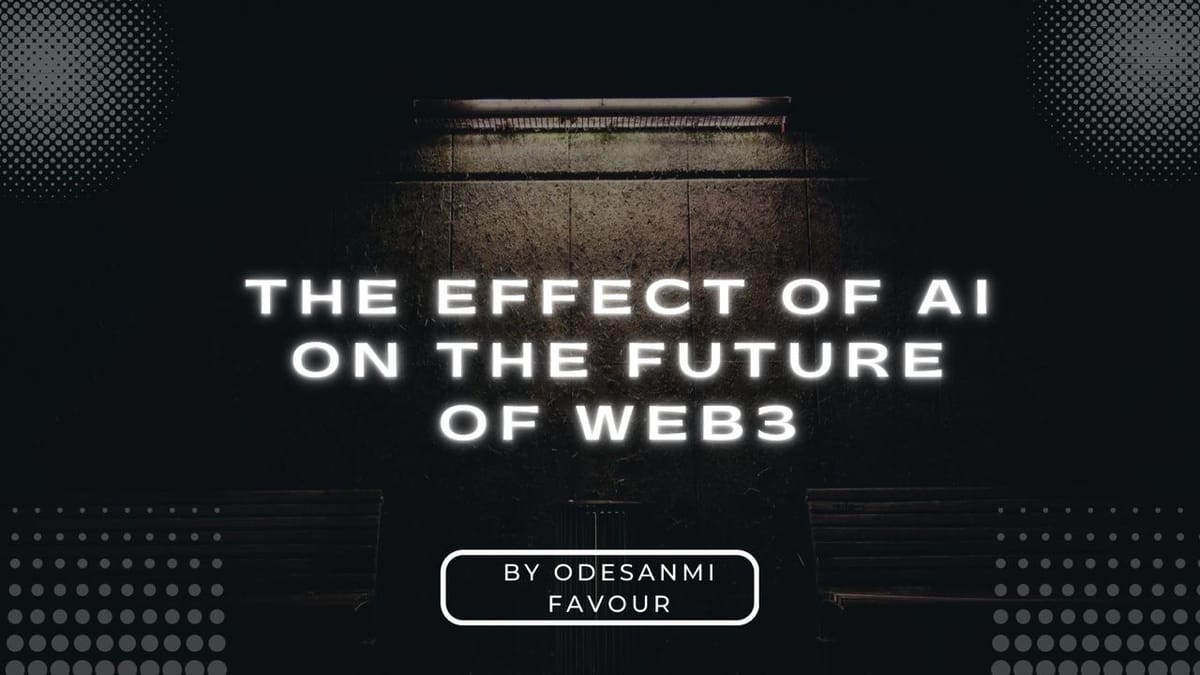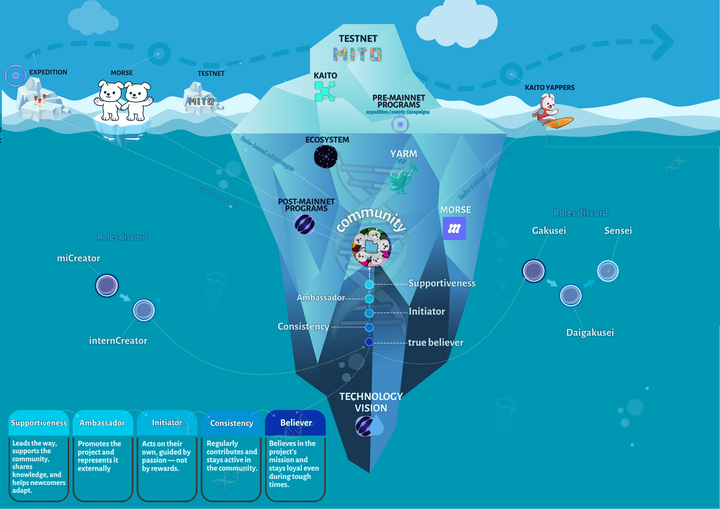The Effect of AI on the Future of Web3

Introduction
Web3, the decentralized internet built on blockchain technology, is redefining digital interactions by prioritizing user ownership, privacy, and trustless systems. Artificial Intelligence (AI), with its capacity for data analysis, automation, and predictive modeling, is emerging as a transformative force in accelerating Web3’s potential. The convergence of AI and Web3 is not only enhancing the functionality of decentralized systems but also addressing critical challenges like scalability, security, and user adoption. However, it also raises questions about privacy, computational demands, and governance in a decentralized world.
In this article, we explore:
1. Enhancing Decentralized Applications (dApps) with AI-Driven Functionality
2. AI-Powered Security and Trust in Web3 Ecosystems
3. Personalized User Experiences in Decentralized Environments
Enhancing Decentralized Applications (dApps) with AI-Driven Functionality
Decentralized applications (dApps) are the backbone of Web3, enabling peer-to-peer interactions without intermediaries. AI can elevate dApps by introducing intelligent features such as real-time data processing, autonomous decision-making, and dynamic optimization. By embedding AI into smart contracts or off-chain oracles, developers can create dApps that are more responsive, scalable, and versatile, spanning industries like decentralized finance (DeFi), gaming, healthcare, and supply chain logistics. This integration enhances user engagement and expands Web3’s practical applications.
For Examples;
1. DeFi Yield Optimization: In DeFi, platforms like Yearn Finance or Aave could leverage AI to optimize liquidity pools and lending strategies. For instance, an AI model could analyze historical market data and on-chain transactions to predict volatility, automatically reallocating assets to high-yield pools while minimizing impermanent loss. Such automation reduces the complexity for users, making DeFi more accessible to non-experts.
2. NFT Creation and Curation: Non-fungible tokens (NFTs) are a cornerstone of Web3’s creative economy. AI can enhance NFT marketplaces like OpenSea or Rarible by generating unique digital assets or curating collections. For example, DALL·E-inspired AI models could create procedurally generated artwork for NFTs, with metadata stored on-chain to ensure authenticity. Additionally, AI-driven recommendation engines could suggest NFTs based on a user’s collecting history, boosting market liquidity.
3. Web3 Gaming: Decentralized gaming platforms like Axie Infinity or The Sandbox can integrate AI to create immersive experiences. AI-powered non-player characters (NPCs) could adapt to player strategies, with their logic executed via smart contracts to ensure transparency. For instance, an AI-driven NPC in a play-to-earn game could dynamically adjust its difficulty based on a player’s skill, enhancing engagement while maintaining fairness.
4. Supply Chain Transparency: In supply chain dApps, such as those built on VeChain, AI can analyze IoT data to optimize logistics. For example, an AI model could predict delivery delays by processing weather data and on-chain shipment records, triggering smart contracts to reroute goods automatically. This reduces inefficiencies and ensures transparency for all stakeholders.
Impact
AI-driven dApps will make Web3 more functional and appealing to mainstream audiences, driving adoption across sectors. However, integrating AI into blockchains poses challenges, including high computational costs and latency. Most blockchains, like Ethereum, are not designed for resource-intensive AI workloads, necessitating hybrid solutions like off-chain AI computation with on-chain verification. Projects like The Graph or Chainlink CCIP are already exploring such architectures, but scalability remains a hurdle. Additionally, ensuring AI models remain transparent and tamper-proof is critical to preserving Web3’s trustless ethos.
AI-Powered Security and Trust in Web3 Ecosystems
Web3’s decentralized architecture eliminates single points of failure but introduces unique risks, including smart contract vulnerabilities, phishing scams, and sybil attacks. AI can enhance security by detecting threats in real time, automating audits, and verifying identities without compromising privacy. By strengthening trust mechanisms, AI ensures Web3 ecosystems remain secure and reliable, fostering confidence among users, developers, and institutions.
For Examples;
1. Real-Time Smart Contract Auditing: Smart contract exploits, like the $600M Poly Network hack in 2021, highlight the need for robust security. AI-powered tools like Certik or MythX can scan contracts for vulnerabilities before deployment, but future advancements could enable real-time monitoring. For instance, an AI could analyze transaction patterns during a DeFi protocol’s operation, detecting anomalies like reentrancy attacks and pausing contracts via governance mechanisms. This proactive approach minimizes losses and builds user trust.
2. Fraud and Illicit Activity Detection: Blockchain analytics platforms like Chainalysis and Elliptic use AI to track illicit transactions, such as money laundering or ransomware payments. In Web3, AI could extend this capability to decentralized exchanges (DEXs) like Uniswap, flagging suspicious wallet activities in real time. For example, an AI could identify a wallet engaging in wash trading to manipulate token prices, alerting users and regulators while preserving pseudonymity.
3. Decentralized Identity and Authentication: Web3’s pseudonymous nature makes identity verification challenging. AI can enable privacy-preserving authentication for dApps like Civic or SelfKey. For instance, an AI could use zero-knowledge proofs (ZKPs) to verify a user’s age or credentials without revealing personal data, with the process recorded on-chain for auditability. This is critical for compliance in regulated sectors like DeFi or tokenized real estate.
4. Sybil Attack Prevention: In decentralized governance systems like DAOs, sybil attacks—where malicious actors create multiple identities to influence votes—pose a threat. AI can analyze voting patterns and wallet histories to detect coordinated behavior. For example, an AI could flag a DAO proposal receiving votes from newly created wallets with minimal transaction history, prompting further scrutiny.
Impact
AI-driven security solutions will make Web3 more resilient, encouraging institutional and retail adoption. However, AI models themselves are vulnerable to adversarial attacks or biases, which could undermine trust if not addressed. Decentralized AI governance, such as community-driven model validation on platforms like Ocean Protocol, is essential to ensure transparency. Additionally, integrating AI with blockchain’s immutable ledger requires balancing computational efficiency with decentralization, as centralized AI servers could reintroduce single points of failure.
Personalized User Experiences in Decentralized Environments
Web3’s focus on user sovereignty often comes at the cost of complex interfaces and steep learning curves, deterring mainstream adoption. AI can bridge this gap by delivering personalized, intuitive experiences while respecting decentralization principles. From tailored content curation to predictive analytics, AI can make Web3 platforms as user-friendly as Web2 counterparts, all while preserving privacy and control over data.
For Examples;
1. Decentralized Social Media Curation: Platforms like Lens Protocol or DeSo aim to replace centralized social media with user-owned networks. AI can enhance these platforms by curating personalized feeds based on on-chain user preferences. For example, an AI could analyze a user’s interactions with posts or creators, stored as NFTs or attestations, to recommend relevant content without relying on opaque algorithms. Users could even audit the AI’s logic via blockchain transparency
2. Web3 E-Commerce Personalization: Decentralized marketplaces like Boson Protocol or Origin Protocol enable peer-to-peer commerce with tokenized goods. AI can personalize shopping experiences by suggesting products based on purchase history or browsing patterns, with data stored on-chain to ensure privacy. For instance, an AI could recommend eco-friendly tokenized products to a user who frequently buys sustainable NFTs, boosting engagement and sales.
3. Simplified Wallet Interactions: Crypto wallets like MetaMask or Trust Wallet are gateways to Web3 but can overwhelm new users. AI-powered assistants could streamline wallet management by suggesting optimal gas fees, warning about phishing sites, or explaining transaction risks in plain language. For example, an AI could detect a user attempting to interact with a malicious dApp and display a warning, reducing the risk of asset theft.
4. Predictive Analytics for DAOs: Decentralized autonomous organizations (DAOs) like MakerDAO rely on community governance, which can be slow and fragmented. AI could predict voter sentiment by analyzing on-chain proposals and off-chain discussions (e.g., on Discord or Snapshot). For instance, an AI could forecast the outcome of a governance vote and recommend strategies to align stakeholders, streamlining decision-making.
Impact
AI-driven personalization will lower Web3’s entry barriers, making it accessible to billions of users accustomed to Web2’s seamless interfaces. However, personalization must avoid replicating Web2’s data monopolies. Innovations like federated learning—where AI models train on decentralized datasets—or on-chain computation, as explored by projects like Phala Network, are critical to preserving privacy. Additionally, ensuring AI recommendations remain unbiased and transparent is essential to maintaining user trust in decentralized systems.
Conclusion
The integration of AI and Web3 is a game-changer, unlocking a future where the internet is decentralized, intelligent, and user-centric. AI enhances dApps with dynamic functionality, strengthens security through real-time threat detection, and delivers personalized experiences that rival Web2’s convenience. From optimizing DeFi yields to curating NFT collections and simplifying wallet interactions, AI is addressing Web3’s biggest pain points—scalability, security, and usability.
However, this convergence is not without challenges. AI’s computational demands strain blockchain’s decentralized infrastructure, requiring innovations in off-chain processing and layer-2 solutions. Privacy concerns loom large, as AI’s data-hungry nature could clash with Web3’s user-sovereignty ethos. Governance is another hurdle, as centralized AI models risk undermining decentralization unless communities adopt transparent, decentralized alternatives.
As Web3 evolves, projects like Chainlink, The Graph, and Ocean Protocol are laying the groundwork for AI-blockchain synergy, while DAOs experiment with decentralized AI governance. The path forward requires balancing efficiency with decentralization, ensuring AI empowers users rather than controlling them. If successful, AI and Web3 will create a digital ecosystem that is not only trustless and transparent but also intelligent and inclusive, redefining how we interact with the internet.



Comments ()